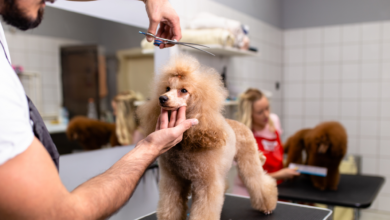How To Move With Your Pets – 2024 Guide

If you’ve read any of our past moving tips, you’ll know that moving day is only one element of the process. We’re happy to assist you with much more in the planning and preparation stages. The same guidelines apply when moving with pets. So there are a few things you should do for your animal friend in the weeks leading up to your move.
Before Moving Day

To begin, you should maintain their everyday schedule. They’ll undoubtedly notice when you start packing and the house starts to appear different. If your dog is well-acquainted with you, he or she will be aware when you are ready to leave for a vacation or a business trip for a few days. They notice the packed luggage and the shift in your demeanor. A move is stressful for you and your family, and your dogs feel the same way. Your pets will be more relaxed if you are calm.
We also urge that you see a veterinarian before making the move. Notify your veterinarian that you will be moving shortly, and follow his or her recommendations. Take their suggestions into consideration. They may give your dog anti-anxiety medication to make moving day go more smoothly.
As previously stated, you should maintain as much calm as possible. Your voice may become stiff or worried when you’re on the phone with the moving company or friends and relatives concerning the move. Your dog is aware of the situation. As a result, you should try to remain calm when discussing the relocation.
As movers pack more and more items, your dog will notice the boxes piling up and the changes in your home. As you sort and organize everything, they will notice things scattered about the house. As you prepare for the relocation, they will see and smell people moving in and out of your home. A professional may be hired to disconnect your computers, television, and home security systems, and many moving companies do an in-person survey to evaluate charges.
Dogs are creatures of habit, and they are aware of all of the big changes taking place in their environment. They can tell when things are changing and when they aren’t. When you relocate, everything changes. As a result, your dog will notice.
Even if dogs are unable to grasp our human language, they can sense the energy that emanates from your voice. Despite how foolish it may seem, you should talk to your dog and tell them that everything will be well, that they will accompany you, and such general assurances. Basically, throughout the day, give your dog a loving pep talk! Use a soothing tone of voice to reassure them that, even though things are changing, everything will be fine and Safeboundmoving.com has your back!
As previously stated, you should keep your dog’s routine before, during, and after the relocation. Though you won’t be able to keep everything the same, especially on moving day, you should
try to maintain as much consistency as possible in their routine. Feed them at the same time, for example. At the same time, take them for a walk. They might rapidly become anxious and stressed if their routine is disrupted.
It’s a good idea to give your dog more exercise than usual in the weeks leading up to moving day. This gives them greater structure and an outlet for all of their pent-up neurotic energy.
If your dog hasn’t been crate trained yet, moving is a wonderful time to start. During the commotion of a move, their container acts as a safe haven. They can feel comfortable and peaceful in their cage when multiple people are packing and items are moving. To crate train your dog, make the cage a positive environment. Fill it with their favorite blanket and toys. When your dog is in it, give them lots of treats. The goal is to make the cage a safe and comfortable environment for them.
Moving Day

Take all of your veterinarian’s suggestions with you on moving day. Keep your dog at a friend’s house or in a room where no one enters in their kennel. For dogs, moving day is the ideal storm. There will be a lot of strangers coming and going, doors will be continually open, and heavy objects will be moving around. It’ll be a well-orchestrated mess. The day of your move isn’t the best time to put your dog’s obedience to the test.
You have three alternatives for transporting your dog to his new home. You can drive them, travel with them, or employ pet movers to transport them to their new home. Driving is the least
stressful choice for your dog, so we recommend it. They’ll be pleased to stay with their familiar owners, and you’ll have lots of opportunities to stop and give them some exercise. Unfortunately, airlines and airports are extremely stressful for dogs, and pet relocation services can be extremely costly.
If you must fly, there are a few things you can do to help your frightened dog relax. Adaptil collars or sprays can help calm stressed dogs by mimicking the mother’s calming pheromones. For dogs, the ThunderShirt is a form of weighted blanket. It evenly distributes pressure across the back and sides of the dog. Before using any of these gadgets, always visit your veterinarian. If your veterinarian approves, test the product on your dog several times before moving day.
In The New House

When you move into a new place, it will take some time for your dog to adjust to the new surroundings. As a result, crate training will be useful in this new location. Remember, the goal of crate training is to provide a secure environment for your dog.
Maintain the regimen we discussed earlier in this article. The key to settling your dog into your new home is to stick to a routine. You should preserve the same schedule even if the configuration is changed.
Moving is stressful enough as it is, but adding a dog to the mix adds another layer of concerns. You must remain calm in order for your dog to remain calm. Maintain a close relationship with your veterinarian. Keep the routines that your dog is accustomed to. Consider purchasing any of the anti-anxiety devices we suggested before. Use crate training to your advantage. Also, keep in mind that time will be your best friend in your new home. If you keep all of these considerations in mind, moving with your dog should be a breeze.




